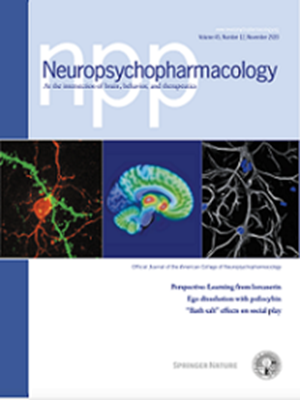选择性KOR拮抗剂改变个体化脑系统的功能斑块大小:来自情绪和焦虑谱系障碍(FAST-MAS)快速失败试验的结果。
IF 6.6
1区 医学
Q1 NEUROSCIENCES
引用次数: 0
摘要
在我们之前的研究中,我们对快感缺乏症患者进行了跨诊断,结果表明,与安慰剂相比,选择性κ-阿片受体(KOR)拮抗剂治疗8周后,在货币激励延迟任务的奖励预期期间,fMRI腹侧纹状体激活增强。然而,大脑结构的个体差异可能会限制这一发现在精准医学背景下的翻译。在这里,我们采用了一种个体特异性的方法来阐明选择性KOR拮抗剂对快感缺乏症个体皮层-皮层下奖赏回路的影响。64名在FAST-MAS研究中完成治疗前和治疗后MRI扫描的缺乏症患者(30名服用KOR拮抗剂,34名服用安慰剂)被纳入该分析。采用个体化脑系统功能脑映射方法,在个体水平上绘制功能网络,并获得个体特异性皮质斑块和皮质下-皮质簇。进行统计分析,以检查治疗前和治疗后斑块和簇大小的变化,以及它们与临床认知测量的关系。ROI分析显示,在KOR拮抗剂治疗后,额顶叶控制网络内的右侧内侧后前额叶皮层斑块大小显着减少,而眼眶前额叶边缘网络内的三个右侧皮质下簇(白球、杏仁核和丘脑)斑块大小显着增加。简而言之,我们应用了最近开发的计算神经成像方法来检查FAST-MAS参与者在接受8周的KOR拮抗剂治疗缺乏症之前和之后的个性化脑系统的变化。我们的研究结果显示,在KOR拮抗剂治疗后,在快感缺乏相关的大脑区域,功能性皮质斑块和皮质下-皮质簇大小发生了变化。本文章由计算机程序翻译,如有差异,请以英文原文为准。

Selective KOR antagonist alters functional patch sizes in individualized brain system: results from the Fast-fail Trial in Mood and Anxiety Spectrum Disorders (FAST-MAS)
In our prior study involving a transdiagnostic sample of individuals with anhedonia, we showed that an 8-week administration of a selective κ-opioid receptor (KOR) antagonist enhanced fMRI ventral striatal activation during reward anticipation in the Monetary Incentive Delay task as compared to a placebo. However, individual differences in brain architecture may limit the translation of this finding to the context of precision medicine. Here, we adopted an individual-specific approach to elucidate the effects of selective KOR antagonism on cortical-subcortical reward circuits in individuals with anhedonia. Sixty-four participants with anhedonia (30 KOR Antagonist, 34 Placebo) who completed both pre- and post- treatment MRI scans in the FAST-MAS study were included in this analysis. Using an individualized-brain-systems-functional-brain-mapping approach, functional networks were mapped at the individual level, and individual-specific cortical patches and subcortical-cortical clusters were obtained. Statistical analyses were conducted to examine the pre- and post-treatment changes in patch and cluster sizes, as well as their relationships with clinical-cognitive measures. ROI analyses revealed a significant patch size decrease in the right medial posterior prefrontal cortex within the frontoparietal control network, and significant size increases in three right subcortical clusters – pallidum, amygdala, and thalamus – within the orbitofrontal-limbic network, following KOR antagonist treatment. In short, we applied recently developed computational neuroimaging approaches to examine changes in the individualized brain systems of FAST-MAS participants before and after eight weeks of KOR antagonist treatment for anhedonia. Our results revealed alterations in functional cortical patch and subcortical-cortical cluster sizes in anhedonia-related brain regions following KOR antagonist treatment.
求助全文
通过发布文献求助,成功后即可免费获取论文全文。
去求助
来源期刊

Neuropsychopharmacology
医学-精神病学
CiteScore
15.00
自引率
2.60%
发文量
240
审稿时长
2 months
期刊介绍:
Neuropsychopharmacology is a reputable international scientific journal that serves as the official publication of the American College of Neuropsychopharmacology (ACNP). The journal's primary focus is on research that enhances our knowledge of the brain and behavior, with a particular emphasis on the molecular, cellular, physiological, and psychological aspects of substances that affect the central nervous system (CNS). It also aims to identify new molecular targets for the development of future drugs.
The journal prioritizes original research reports, but it also welcomes mini-reviews and perspectives, which are often solicited by the editorial office. These types of articles provide valuable insights and syntheses of current research trends and future directions in the field of neuroscience and pharmacology.
 求助内容:
求助内容: 应助结果提醒方式:
应助结果提醒方式:


